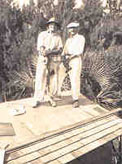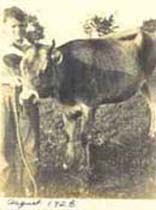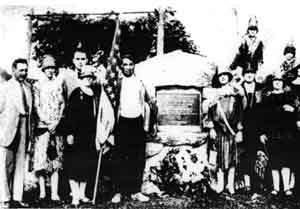HISTORY OF CHEROKEE FARMS . . . page 2 |
|
H. R. Anstis bought the farm on August 27, 1925 from O.E. Thomas. Harold Robjohns Anstis was born the son of Thomas Anstis and Margaret Robjohns at Ugborough, Devonshire, England in 1886. He sailed from Southhamton, England on April 26 and landed in New York on May 1, 1911. On March 3, 1912, he married Florence Eliza James, and lived for a short time in New Jersey. They had three sons: Thomas Harold, James Robert, and Edward Herbert. Little Harold died of a fever when he was about 4 years old, and is buried in West Palm Beach, Florida in an unmarked grave in Woodlawn Cemetary. |
Moving from New Jersey to Florida, In 1927, Harold Anstis had just finished two majour construction jobs in south Florida and deposited his money in the bank. About that time, all over the country the banking system began to collapse. The first to close in West Palm Beach was Dixie National Bank - the one across the street from Harold's bank. Sensing the coming doom of the depression, he decided to withdraw his money while it was still available and move back north. He took his wife, Florence, and their two sons, Jim and Ed, and moved into the house on what was now known as "The Cherokee Farm." |
|
There was always work to be done on the farm, but the results supplied all the needs for the family, and even provided for some less prosperous neighbours. Honesty, hard work, and generosity have always been the sustaining philosophy of Cherokee Farms. But, sometimes there was fun, too. In the summer of 1928, Ed took his heifer to the Bradley County fair, winning first prize. |
The Anstis family lived happily on Cherokee Farm only a brief time. On December 3, 1929, Florence died of heart failure while Harold was away on business. She was home on the farm with her two sons, Jim, then 14, and Edward, who was only 12 years old. Harold returned to Cleveland, buried his wife, and left the two boys on the farm with caretakers while he returned to Florida. When the boys reached their seventeenth birthdays, Harold moved them back to their Hobe Sound, Florida homestead, where he taught each of them a craft. Jim learned brick masonry; Ed learned carpentry and cabinet making. Over several years, Harold sold and re-bought pieces of the farm, finally disposing of the last piece in 1945 when he sold it to T. Lloyd McLain. |
To commemorate the work Chief Walker accomplished for the people
|
cfi © 2000-2011 | Contact the Webmaster |

 H.R. Anstis developed
a prosperous a construction business in Palm Beach and Martin
counties during the building boom taking place in the early and mid-1920's.
He built houses and public buildings in West Palm Beach, and on Jupiter
Island for wealthy vacationers to spend their winters.
H.R. Anstis developed
a prosperous a construction business in Palm Beach and Martin
counties during the building boom taking place in the early and mid-1920's.
He built houses and public buildings in West Palm Beach, and on Jupiter
Island for wealthy vacationers to spend their winters.
 of the Cherokee Nation, a granite boulder with a brass plaque was erected on the roadside in front of the house on Cherokee Farm. It was dedicated on June 14, 1928 by the Ocoee Chapter of the Daughters of the American Revolution. Present at the dedication were H.R. Anstis and James F. Corn, Sr., the Jack Walker historian. The plaque read: "Location of House and Grave of Chief Jack Walker; Greatest of His Tribe, and a Servant of Our Government."
of the Cherokee Nation, a granite boulder with a brass plaque was erected on the roadside in front of the house on Cherokee Farm. It was dedicated on June 14, 1928 by the Ocoee Chapter of the Daughters of the American Revolution. Present at the dedication were H.R. Anstis and James F. Corn, Sr., the Jack Walker historian. The plaque read: "Location of House and Grave of Chief Jack Walker; Greatest of His Tribe, and a Servant of Our Government."